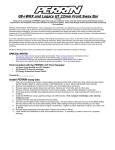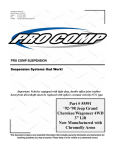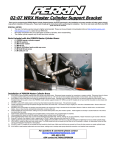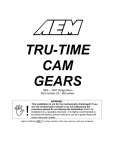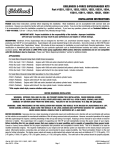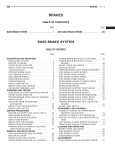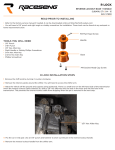Download REMOVAL AND INSTALLATION (Continued)
Transcript
NS REMOVAL AND INSTALLATION (Continued) BRAKES 5 - 57 (2) Raise vehicle on jackstands or centered on a hoist. See Hoisting in the Lubrication And Maintenance Group of this service manual. CAUTION: Before removing the brake tubes from the proportioning valve, the proportioning valve and the brake tubes must be thoroughly cleaned. This is required to prevent contamination from entering the proportioning valve or the brake tubes. (3) Remove the 4 chassis brake tubes from the inlet and outlet ports of the proportioning valve (Fig. 134). Fig. 133 Proportioning Valve Attachment To Vehicle INSTALL CAUTION: When mounting the original or a replacement proportioning valve on the frame rail of the vehicle install the mounting bolts in only the two forward holes of the mounting bracket (Fig. 133). (1) Install proportioning valve assembly on the frame rail of the vehicle. Install the proportioning valve assembly attaching bolts (Fig. 133). Tighten the attaching bolts to a torque of 14 N·m (125 in. lbs.). (2) Install the 4 chassis brake lines (Fig. 132) into the inlet and outlet ports of the proportioning valve assembly. Tighten all 4 line nuts to a torque of 16 N·m (142 in. lbs.). (3) Bleed the brake system thoroughly enough to ensure that all air has been expelled from the hydraulic system. See Bleeding Brake System in the Service Adjustments section in this group of the service manual for the proper bleeding procedure. (4) Lower the vehicle to the ground. (5) Road test the vehicle to verify proper operation of the vehicles brake system. Fig. 134 Chassis Brake Tubes At Proportioning Valve (4) Remove the 2 bolts (Fig. 135) attaching the proportioning valve to the proportioning valve mounting bracket. Remove the proportioning valve from the mounting bracket. PROPORTIONING VALVE (W/O ABS BRAKES) The components of the proportioning valve assembly are not serviceable or replaceable. If a component of the proportioning valve assembly is not functioning properly, the proportioning valve must be replaced as an assembly. REMOVE (1) Using a brake pedal depressor, move and lock the brake pedal to a position past its first 1 inch of travel. This will prevent brake fluid from draining out of the master cylinder when the brake tubes are removed from the proportioning valve. Fig. 135 Proportioning Valve Mounting (5) Remove the hooked end of the proportioning valve actuator (Fig. 136) from the isolator bushing on the lever of the height proportioning valve (Fig. 136). 5 - 58 NS BRAKES REMOVAL AND INSTALLATION (Continued) attach components to the front suspension cradle have an anti—corrosion coating due to the suspension cradle being made of aluminum. Only Mopar replacement fasteners with the required anti-corrosion coating are to be used if a replacement fastener is required when installing a brake chassis line or flex hose. Only double wall 4.75mm (3/16 in.) steel tubing with Al-rich/ZW-AC alloy coating and the correct tube nuts are to be used for replacement of a hydraulic brake tube. Fig. 136 Actuator Attachment To Proportioning Valve INSTALL (1) Install the hooked end of the actuator on the proportioning valve lever (Fig. 136). Be sure isola- tor bushing on lever of proportioning valve (Fig. 136) is fully seated in hook of actuator. NOTE: When installing height sensing proportioning valve on mounting bracket be sure proportioning valve shield (Fig. 135) is installed between the proportioning valve and the mounting bracket. (2) Install height sensing proportioning valve on mounting bracket. Install the proportioning valve attaching bolts (Fig. 135). Tighten the attaching bolts to a torque of 23 N·m (200 in. lbs.). (3) Install the 4 chassis brake lines (Fig. 134) into the inlet and outlet ports of the proportioning valve. Tighten all 4 line nuts to a torque of 16 N·m (142 in. lbs.). (4) Adjust the proportioning valve actuator. See Height Sensing Proportioning Valve in the Adjustment Section in this group of the service manual for the adjustment procedure. (5) Bleed the brake system thoroughly to ensure that all air has been expelled from the hydraulic system. See Bleeding Brake System in the Service Adjustments section in this group of the service manual for the proper bleeding procedure. (6) Lower the vehicle to the ground. (7) Road test the vehicle to verify proper operation of the vehicles brake system. HYDRAULIC BRAKE TUBES AND HOSES CAUTION: When installing brake chassis lines or flex hoses on the vehicle, the correct fasteners must be used to attach the routing clips or hoses to the front suspension cradle. The fasteners used to NOTE: On vehicles equipped with traction control, the primary and secondary hydraulic tubes between the master cylinder and the hydraulic control unit are 6 mm (15/64 in.). These tubes are also coated with the Al-rich/ZW-AC alloy and must be replaced with tubes having the same anti-corrosion coating. Be sure that the correct tube nuts are used for the replacement of these hydraulic brake tubes. Care should be taken when replacing brake tubing, to be sure the proper bending and flaring tools and procedures are used, to avoid kinking. Do not route the tubes against sharp edges, moving components or into hot areas. All tubes should be properly attached with recommended retaining clips. If the primary or secondary brake tube from the master cylinder to the ABS Hydraulic Control Unit (HCU) or the brake tubes from the HCU to the proportioing valve require replacement, only the original factory brake line containing the flexible section can be used as the replacement part. This is required due to cradle movement while the vehicle is in motion. PARK BRAKE PEDAL MECHANISM REMOVE (1) Disconnect negative (ground) cable from the battery and isolate cable from battery terminal. (2) Remove sill scuff plate from left door sill. (3) Remove the left side kick panel. (4) Remove the steering column cover from the lower instrument panel. (5) Remove the reinforcement from the lower instrument panel. (6) Lock out front park brake cable using the following procedure. Grasp the exposed section of the front park brake cable and pull rearward on it. While holding the park brake in this position, install a pair of locking pliers on the front park brake cable just rearward of the second body outrigger bracket (Fig. 137). (7) Remove the front park brake cable from the park brake cable equalizer.




